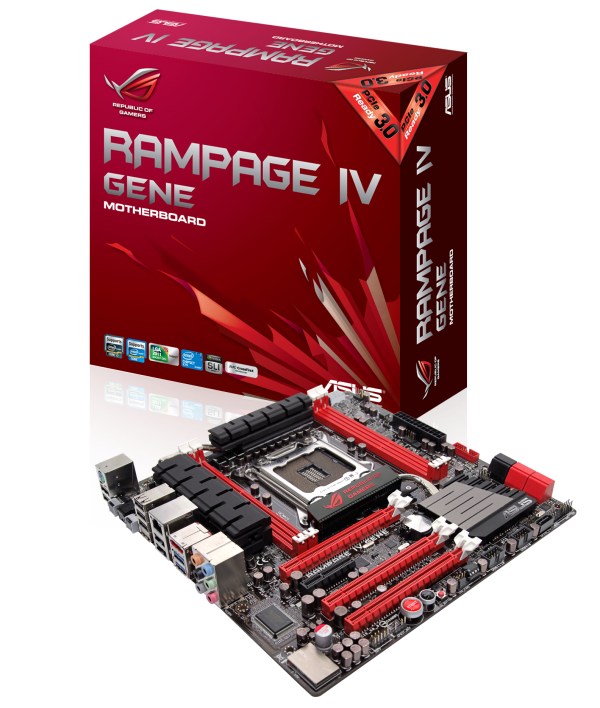ASUS Republic of Gamers and X79 ROG Review – Rampage IV Gene, Formula and Extreme
by Ian Cutress on August 3, 2012 1:00 PM EST- Posted in
- Motherboards
- Asus
- X79
- ROG
If a user wants the top end of performance, they are going to have to look towards the X79 and Sandy Bridge-E platform. If they want the best of that platform, it would not hurt to start looking at the Republic of Gamers range to see if a motherboard would suit them. In this review, we have analyzed the Rampage IV Gene, the Rampage IV Formula and the Rampage IV Extreme - the entire ASUS Republic of Gamers range for this platform, with a mélange of real-world tests and some more exotic extreme enthusiast scenarios.
The Republic of Gamers motherboards for X79 do not come in cheap. For a platform where the processor range varies from $300 to $1000, cost is rarely a talking point. However, for completeness, here is how the ROG boards currently stack up price wise (from Newegg) against the rest of the X79 range (some of which we at AnandTech have tested):
$445 - EVGA X79 Classified
$430 - ASUS Rampage IV Extreme
$390 - MSI Big Bang-XPower II
$370 - ASRock X79 Champion
$360 - ASUS Rampage IV Formula
$350 - Gigabyte G1. Assassin2
$345 - ASRock X79 Extreme9
$310 - ASUS P9X79 Pro
$310 - ECS X79R-AX Black Extreme
$300 - EVGA X79 SLI
$280 - ASUS Rampage IV Gene
$265 - Intel DX79SI
$260 - ASUS P9X79
$245 - ASRock X79 Extreme7
$240 - Gigabyte X79-UD3
$230 - Biostar TPower X79
$225 - ASRock X79 Extreme4
$214 - ASRock X79 Extreme4-M
With the Formula and Extreme both catering for the more-than-dual GPU crowd, it is unsurprising that they are more at the upper end of the price range. The Rampage IV Gene is the most expensive of the MicroATX boards, but it does put some of the full sized ATX boards above it to shame in terms of performance.
ASUS Rampage IV Gene Conclusion
High end, small(er) form factor motherboards can often be a bit of a quandary. On the one hand, a user could have a serious processor costing around $1000 with all the bells and whistles a processor should have - why would they consider pairing it with a motherboard that limits itself on size? The answer lies in usage scenarios, and ultimately performance.
The Gene is not a normal mATX board - ASUS have asked me to state explicitly that the Gene is more of a entry level ROG motherboard rather than one aimed at SFF systems. It gets the benefit of ROG development, whilst retaining a modicum of mobility and the utmost of performance.
In my view, the Gene is a great product if a user has two PCIe devices or less. In terms of new hardware over other X79 products, the ROG glaze expands to the focused SupremeFX III audio and the Intel NIC, but the selling point of the Gene will be in the ASUS branded features. ROG Connect for example will let a user manage a PC from a mobile device; the fan headers on board are typical of ASUS and better than any other manufacturers' implementation. USB BIOS Flashback helps users updating the BIOS without CPU, Memory or a VGA, and the heatsinks are buffed up to take the strain of an enthusiast system.
The main competition from the Gene comes from the boards priced around it - the Intel DX79SI for example is a full sized ATX board with dual Intel NICs or the ASUS P9X79 has a full complement of memory slots. Compared to the other mATX boards, such the cheap-as-chips ASRock X79 Extreme4-M, the Gene is similar in terms of outward facing hardware, but surpasses the 4-M for performance and feature set. This is not forgetting the Gene also come with 3-years warranty and ASUS Premium Service for North American customers.
The Gene is not to be taken lightly. Despite the extra cost over the Extreme4-M, the Gene still gets big thumbs up from the ASUS ROG garnish and performance thanks to ASUS MultiCore Enhancement. Overclocking was great too, matching the other ROG boards easily enough and beating many of the other X79 competitors for performance and ease-of-use.
The Gene is still missing a delicate spark. The extras in the box were perhaps missing a little bonus, such as a USB 3.0 panel. If I were in the design team, I would consider reshuffling the IO panel to rid the empty space, and consider stripping out the audio and placing it on an add-in card, then have the PCIe as x1, x16, x8, x16. There would perhaps be space for a built-in WiFi card (or include it in the audio card).
Nevertheless, the Gene is still a great product for an enthusiast. As a result, I would like to give the Rampage IV Gene an AnandTech Editors' Choice Bronze Award.

ASUS Rampage IV Gene
Bronze Award











34 Comments
View All Comments
jontech - Friday, August 3, 2012 - link
But sounds kind of cool,.Helps that Asus makes it :)
Paulman - Friday, August 3, 2012 - link
Asus Republic of Gamers also holds Starcraft tournaments, as well! That's how I first heard of their brand. In fact, the ASUS ROG Starcraft II Summer 2012 tournament is on right now and I'm watching a game vs. EG.IdrA and EG.Puma (same team, but one American teammate versus a Korean teammate).For more info on this tourney, see: http://rog.asus.com/142982012/gaming/join-the-rog-...
primeval - Friday, August 3, 2012 - link
A fun tournament thus far.For the branding portion of this article, I highly recommend checking out some of ASUS ROG's commercials. They have been playing throughout the aforementioned tournament and I have to say they are probably the best hardware commercials I have ever seen in terms of production quality. I think that if you see a few of those commercials, you may be able to further rationalize the branding award.
Meaker10 - Friday, August 3, 2012 - link
1x/16x/8x/16x would kill any dual card setup in a micro atx case, kinda defeating the point....just4U - Friday, August 3, 2012 - link
the 8x slot is rather pointless...danjw - Friday, August 3, 2012 - link
I would rather see an article on the Ivybridge ROG motherboards then the Sandybridge-E ones. These are very niche boards, though I guess that is only slightly less true of the Ivybridge boards. For heavily threaded and memory intensive applications Sandybridge-E will win. But not really on much else, though they are chosen by some just because they are the most expensive.StevoLincolnite - Friday, August 3, 2012 - link
Also, Sandy Bridge overclocks higher and throws out less heat, because of the silly design choice that Intel made in regards to the heat spreader compound.Not a problem for those who are up to the task of removing the IHS or lapping.
Sad part is that Ivy Bridge actually has nice thermals and power consumption at stock; which could have translated well for enthusiasts.
IvyBridge-E should be out within the next year, haswell will get released and the cycle shall continue.
Hopefully we get 8 core Ivybridge-E chips, which is severely lacking on the Socket 2011 platform with the 3930K's being die harvested 8 core chips, plus most socket 2011 motherboards will take an Ivybridge-e chip anyway, when they're released.
danjw - Friday, August 3, 2012 - link
I was just looking at "leaked" slide that shows Ivy Bridge-E out in Q3 2013 and Haswell out in Q2 2013. I really don't see what the point is of an Ivy Bridge-E if Haswell beats it to the market. With Sandy Bridge-E they released it before the Ivy Bridge tock. I just don't see why that would make much sense.Assimilator87 - Saturday, August 4, 2012 - link
Haswell will probably be limited to four cores, whereas Ivy Bridge-E will scale up to ten cores.mapesdhs - Wednesday, May 9, 2018 - link
I was hunting for R4E refs and found this. It's strange reading what people expected was going to happen back when the R4E was new. IB-E with 10 cores eh? Oh well. Mind you, that did happen with IB-EP, and infact the XEON E5-2680 v2 is one of the best upgrades one can do for an X79 mbd, at least for threaded performance anyway. Hard to avoid wondering how things would have panned out if the 3930K had simply been a fully functional 8-core in the first place, instead of the crippled sampled chip consumers were offered. However, I obtained quite a few, and they still work pretty well, especially with so many PCIe lanes to play with, and it's cool being able to use a 950 Pro to boot from NVMe (comes with its own boot ROM), though the ROG forum does have a thread with custom BIOS profiles available to add native NVMe boot support to various ASUS mbds.